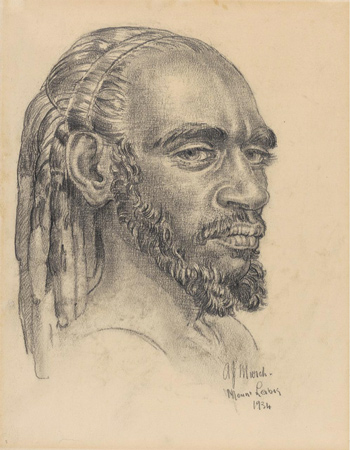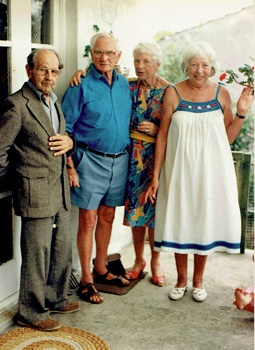WRITING
Critics and Fellows
After Arthur Murch’s trips to Central Australia, exhibitions of his work of drawings and paintings, predominantly of Central Australian subject matter, were held in:
• Sydney – The Macquarie Galleries, May 30th – June 12th, 1933
• Melbourne – The Fine Art Society’s Gallery, May 17th – May 29th, 1934
Here are extracts of critical reviews these exhibitions received:
Sydney Morning Herald, May 31st, 1933:
…..In looking at the landscapes, one cannot avoid a mental comparison with those of Mr. Hans Heysen; for Mr. Heysen has also been to Central Australia in search of subject matter… Here is an excellent example of two artists looking at the same sort of scenery and recording their impressions in dissimilar ways. The work of each one is valid; Mr Heysen’s in its smooth, sharp , flattish planes; and Mr. Murch’s in a richer, deeper, more disturbed and vibrant way. The primary difference is that, in Mr. Murch’s painting, one is conscious of atmosphere and of glowing heat; while in Mr. Heysen’s the spectator seems to be looking at the strange, gaunt mountains through a vacuum. Sometimes the colouring of Mr. Murch’s scenes seems fantastic and unreal. In “Gosses Range, Evening” for instance , there is a reminiscence of the curious intensity of Gauguin in the burning hue of the sand…..Only a proportion of the paintings are landscapes, fully worked out. The rest are either sketches in oil, obviously dashed off with some speed, but always attractive in their catching of the lights and shades of nature and their natural sense of pattern; or else they are figure studies. It is in this latter department that Mr. Murch appears in his most striking mood. First of all, attention centres on “Allen” which has been bought by the trustees of the National Gallery. There is remarkable force and conviction in this head of an aboriginal boy. It has simplicity, dignity, and a splendid unity of feeling in the expression of volume. The character-drawing is very penetrating indeed….
Sun Herald Melbourne, May 17th, 1934. Review by George Bell:
Yet another artist has succumbed to the fascination of Central Australia. Arthur. J. Murch , whose exhibition at the Fine Art Society Gallery will be opened today by D. J. Mahoney, Director of the National Museum, has made good use of Central Australian motifs in three different aspects; aesthetic, ethnographic and topographic. Mr Murch is a scholarship winner who, after his study abroad, acted on his return as assistant to George Lambert for some years. The influence he underwent during this time is evident in the sources of his constructive drawing and in his technical manner. Many portraits of natives and landscapes of their surroundings are included in this exhibition. The place of honour has been accorded to a portrait study of Walila of the Pentu Pui Tribe.

Walila, Mount Liebig 1934 National Gallery of Victoria
AN ARTIST LOOKS AT THE ABORIGINES
The Fine Art Society’s Gallery, 100 Exhibition Street, opens today with an exhibition of 49 works by Arthur J. Murch. This is his first exhibition in Melbourne and his first expression in sculpture, drawing, and painting is novel, being chiefly illustrative of Central Australia and the aborigines. Already we have seen the works of Heysen…. and also the interesting works of Gardner and Battersbee. The remarkable redness and general warmth in the landscape has been evident in the works of the artists mentioned. In the works of Mr. Murch the geological warmth of inland landscape has as still stronger accent. It may be claimed that the artist has perhaps over-emphasised the local colour, as if it were not affected by reflection of coolness from this vivid blue dome of the sky. Few of us have seen the country, but Nature generally contrives an harmonious balance in the colour of her landscape……Mr. Murch gives his impressions of the aborigine without any softening or flattering of their primeval and wild characteristics. His finest drawings are those such as No. 34 “Boy, Pentu Pui”; No. 36 “Ngunkgu”; No. 39, “Ferdinand, Arunta”. He shows several heads and figures of aborigines. All with the exception of No. 15 “Kurblmaltj” , are in warm colour unrelieved by cool tones. His best quality in painting is shown in No. 25 “On the Beach”, two figures sleeping on sunlit sand. It is a lovely arrangement of line and colour and is beautiful…. No. 21 “The Areoplane” has its interest and it reflects some of the sincere and thorough manner of the late George Lambert. Nos. 6, 7, 8 are landscapes from which the natural balance of warm and cold seems to be missing. The sculpture includes No. 46 “His Grace Dr. Kelly, Archbishop of Sydney” and No. 48, “Head of a Child,” silvered bronze.
Melbourne Herald, May 16th, 1934. Review by Blamire Young, the Herald Art Critic:
ARTIST WHO TURNED ETHNOLOGIST
Arthur Murch comes to us from Sydney with a reputation as an artist, both in painting and sculpture. He is still in his twenties, and represents, in his approach to the fine arts, the point of view of young Australia, or that part of it that found in the example of the late George Lambert, A.R.A., an outlet for youthful energy, and an escape from the too stringent and exclusive barriers that Edwardian tradition had erected between them and what they wanted to do.
Young people like Arthur Murch and his friend, Edmund Harvey, are very serious in their purpose. It was in this spirit that led Arthur Murch to join two successive expeditions undertaken by the University of Sydney, under Professor Davies, to obtain some exact knowledge of aboriginal methods of facing periods of drought and other things of that nature. His energy and initiative were of such use to the party that the change from artist to ethnologist took place without comment, and it arrives in Melbourne with his exhibition. There are 45 pictures altogether, and four pieces of modelling, and of these only a very few belong to the period that preceded the ethnological adventure. The aboriginal subjects have been done under the most trying conditions it is possible to imagine. With a temperature of 111 deg. and flies to match, could anything be more discouraging? And yet these works are in many ways carried out with admirable spirit. As records of indomitable will they are unique, though, since they are museum-pieces, they would need some special institution in which to house them. One can imagine how deeply interested Professor Baldwin Spencer would have been in them and their creator.
But how difficult it is to see them as works of art! The central design shows us “Walila” of the Pentu Pui tribe, who grasps his boomerang and keeps a watchful eye on the artist’s proceedings which may, or may not, prove to be innocuous. There is a picture of the Hermannsburg Mission Station to whose water supply so many people contributed their mite a few weeks ago….
__________________________________________________________________________________________________________________________________
Ria Murch collected a summary of exhibition reviews:
PAUL HAEFLIGER, Sydney Morning Herald, June 15th, 1944
Arthur Murch’s paintings at the Macquarie Galleries betray a decided and interesting paradox. Each aim to in turn seems to result in the exact opposite. His chalk head “Study” has the charm of a rococco cherub floating on a pink cloud, yet the drawing in his paintings is overworked, this (work) gives the impression that the artist puts his faith in his great technical accomplishments and that he believes rather in the dictates of his head than those of his heart. Haefliger concludes ‘A purely logical mind in art is always dangerous’….
KENNETH WILKINSON, Present Day Art in Australia No. 2 1948
An artist is sometimes the least reliable critic of his own work. It seems to me that there is a contradiction between what Arthur Murch sets out to do and what he accomplishes. He does not set out to make his canvases glow with temperament or emotion. On the contrary, he sets out to keep his mind cold, unclouded with feeling. The best of his portraits and figure studies exert their appeal – and a very potent appeal it is – not through a literal faithfulness to the outward facts of appearance, but, on the contrary, through sheer poetry of light and colour.
IVOR FRANCIS, 1952
There may be some differences of opinion about Arthur Murch’s greatness as an artist, but there can surely be none about his skill as a painter. Static rather than dynamic, Murch treats his subjects as still life studies expressing himself through technicalities rather than through actual reaction to the subject matter. An important feature of his rare combination of impressionism and cubism which gives one the satisfaction of experiencing the solid form enfolded in an atmosphere of soft lift and colour.
_____________________________________________________________________________________________________________________________________
Edmund Harvey
The Harvey and Murch families hold friendships and connections over many decades.

Arthur, Harvey, Ria and Lorna – early 1980’s
Ria and Arthur felt so close to the Harveys that they named their daughter Michelle Harvey Murch.
Harvey and his wife Lorna were artists. Harvey was a teacher at East Sydney Technical College and in 1978 wrote It Was a Damn Good School . Harvey gives a personal account of his introduction to the art world and his recollections of “The Tech” which is now known as The National Art School.
In serial .pdf form, Edmund Harvey’s It Was a Damn Good School:
Harvey met Murch in 1925 and they travelled in Europe and worked together – including with George Lambert from 1927 – 1930. A recording of a talk at the S. H. Ervin Gallery preserves their memories of this time.
Listen to the two-part audio recording of Harvey, Snekker and Murch discussing working with Lambert. Recorded at S. H. Ervin Gallery in 1978